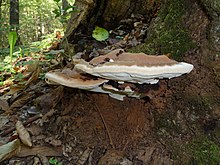Ganoderma applanatum
| Ganoderma applanatum | |
|---|---|
 |
|
| Scientific classification | |
| Kingdom: | Fungi |
| Division: | Basidiomycota |
| Class: | Agaricomycetes |
| Order: | Polyporales |
| Family: | Ganodermataceae |
| Genus: | Ganoderma |
| Species: | G. applanatum |
| Binomial name | |
|
Ganoderma applanatum (Pers.) Pat. |
|
| Synonyms | |
|
|
| Ganoderma applanatum | |
|---|---|
| Mycological characteristics | |
| pores on hymenium | |
| no distinct cap | |
| hymenium is decurrent | |
| lacks a stipe | |
| spore print is brown | |
| ecology is parasitic | |
| edibility: inedible | |
Ganoderma applanatum (the artist's bracket, artist's conk or bear bread) is a bracket fungus with a cosmopolitan distribution.
This fungus grows as a mycelium within the wood of living and dead trees. It forms fruiting bodies that are up to 30–60 centimetres (12–24 in) across, hard, woody-textured, and inedible; they are white at first but soon turn dark red-brown. Brown spores are released from the pores on the underside of the fruiting body. The fruiting bodies are perennial, and may persist for multiple years, increasing in size and forming new layers of pores as they grow.
It is a wood-decay fungus, causing a rot of heartwood in a variety of trees. It can also grow as a pathogen of live sapwood, particularly on older trees. It is a common cause of decay and death of beech and poplar, and less often of several other tree genera, including alder, apple, elm, buckeye and horse chestnut, maple, oak, walnut, willow, western hemlock, Douglas Fir, and Spruce.
A peculiarity of this fungus lies in its use as a drawing medium for artists. When the fresh white pore surface is rubbed or scratched with a sharp implement, dark brown tissue under the pores is revealed, resulting in visible lines and shading that become permanent once the fungus is dried.
The Anne Frank tree in Amsterdam suffered rot from Ganoderma applanatum before it blew over in 2010.
Ganoderma applanatum is known in Japan as kofuki-saru-no-koshikake (コフキサルノコシカケ), literally meaning "powder-covered monkey's bench", and in China as shu-she-ling-zhi (树舌灵芝), where it has long been used in traditional medicines. Studies have shown Ganoderma applanatum contains compounds with potent anti-tumor, antibacterial anti-fibrotic properties.
...
Wikipedia
